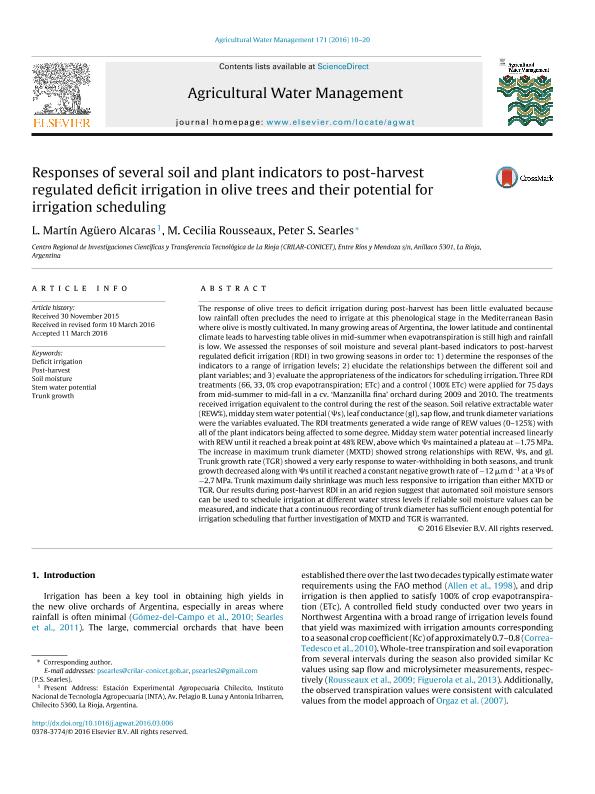Mostrar el registro sencillo del ítem
dc.contributor.author
Agüero Alcaras, Luis Martín

dc.contributor.author
Rousseaux, Maria Cecilia

dc.contributor.author
Searles, Peter Stoughton

dc.date.available
2018-05-03T17:09:47Z
dc.date.issued
2016-06
dc.identifier.citation
Agüero Alcaras, Luis Martín; Rousseaux, Maria Cecilia; Searles, Peter Stoughton; Responses of several soil and plant indicators to post-harvest regulated deficit irrigation in olive trees and their potential for irrigation scheduling; Elsevier Science; Agricultural Water Management; 171; 6-2016; 10-20
dc.identifier.issn
0378-3774
dc.identifier.uri
http://hdl.handle.net/11336/43975
dc.description.abstract
The response of olive trees to deficit irrigation during post-harvest has been little evaluated because low rainfall often precludes the need to irrigate at this phenological stage in the Mediterranean Basin where olive is mostly cultivated. In many growing areas of Argentina, the lower latitude and continental climate leads to harvesting table olives in mid-summer when evapotranspiration is still high and rainfall is low. We assessed the responses of soil moisture and several plant-based indicators to post-harvest regulated deficit irrigation (RDI) in two growing seasons in order to: 1) determine the responses of thei ndicators to a range of irrigation levels; 2) elucidate the relationships between the different soil and plant variables; and 3) evaluate the appropriateness of the indicators for scheduling irrigation. Three RDI treatments (66, 33, 0% crop evapotranspiration; ETc) and a control (100% ETc) were applied for 75 days from mid-summer to mid-fall in a cv. ?Manzanilla fina? orchard during 2009 and 2010. The treatments received irrigation equivalent to the control during the rest of the season. Soil relative extractable water(REW%), midday stem water potential (PHIs), leaf conductance (gl), sap flow, and trunk diameter variations were the variables evaluated. The RDI treatments generated a wide range of REW values (0?125%) with all of the plant indicators being affected to some degree. Midday stem water potential increased linearly with REW until it reached a break point at 48% REW, above which PHIs maintained a plateau at −1.75 MPa.The increase in maximum trunk diameter (MXTD) showed strong relationships with REW, PHIs, and gl.Trunk growth rate (TGR) showed a very early response to water-withholding in both seasons, and trunk rowth decreased along with PHIs until it reached a constant negative growth rate of −12 micrometers d−1 at a PHIs of−2.7 MPa. Trunk maximum daily shrinkage was much less responsive to irrigation than either MXTD orTGR. Our results during post-harvest RDI in an arid region suggest that automated soil moisture sensors can be used to schedule irrigation at different water stress levels if reliable soil moisture values can be measured, and indicate that a continuous recording of trunk diameter has sufficient enough potential for irrigation scheduling that further investigation of MXTD and TGR is warranted.
dc.format
application/pdf
dc.language.iso
eng
dc.publisher
Elsevier Science

dc.rights
info:eu-repo/semantics/openAccess
dc.rights.uri
https://creativecommons.org/licenses/by-nc-sa/2.5/ar/
dc.subject
Deficit Irrigation
dc.subject
Post-Harvest
dc.subject
Soil Moisture
dc.subject
Stem Water Potential
dc.subject
Trunk Growth
dc.subject.classification
Agricultura

dc.subject.classification
Agricultura, Silvicultura y Pesca

dc.subject.classification
CIENCIAS AGRÍCOLAS

dc.title
Responses of several soil and plant indicators to post-harvest regulated deficit irrigation in olive trees and their potential for irrigation scheduling
dc.type
info:eu-repo/semantics/article
dc.type
info:ar-repo/semantics/artículo
dc.type
info:eu-repo/semantics/publishedVersion
dc.date.updated
2018-05-03T13:58:46Z
dc.journal.volume
171
dc.journal.pagination
10-20
dc.journal.pais
Países Bajos

dc.journal.ciudad
Amsterdam
dc.description.fil
Fil: Agüero Alcaras, Luis Martín. Consejo Nacional de Investigaciones Científicas y Técnicas. Centro Regional de Investigaciones Científicas y Transferencia Tecnológica de La Rioja. - Universidad Nacional de La Rioja. Centro Regional de Investigaciones Científicas y Transferencia Tecnológica de La Rioja. - Universidad Nacional de Catamarca. Centro Regional de Investigaciones Científicas y Transferencia Tecnológica de La Rioja. - Secretaría de Industria y Minería. Servicio Geológico Minero Argentino. Centro Regional de Investigaciones Científicas y Transferencia Tecnológica de La Rioja. - Provincia de La Rioja. Centro Regional de Investigaciones Científicas y Transferencia Tecnológica de La Rioja; Argentina
dc.description.fil
Fil: Rousseaux, Maria Cecilia. Consejo Nacional de Investigaciones Científicas y Técnicas. Centro Regional de Investigaciones Científicas y Transferencia Tecnológica de La Rioja. - Universidad Nacional de La Rioja. Centro Regional de Investigaciones Científicas y Transferencia Tecnológica de La Rioja. - Universidad Nacional de Catamarca. Centro Regional de Investigaciones Científicas y Transferencia Tecnológica de La Rioja. - Secretaría de Industria y Minería. Servicio Geológico Minero Argentino. Centro Regional de Investigaciones Científicas y Transferencia Tecnológica de La Rioja. - Provincia de La Rioja. Centro Regional de Investigaciones Científicas y Transferencia Tecnológica de La Rioja; Argentina
dc.description.fil
Fil: Searles, Peter Stoughton. Consejo Nacional de Investigaciones Científicas y Técnicas. Centro Regional de Investigaciones Científicas y Transferencia Tecnológica de La Rioja. - Universidad Nacional de La Rioja. Centro Regional de Investigaciones Científicas y Transferencia Tecnológica de La Rioja. - Universidad Nacional de Catamarca. Centro Regional de Investigaciones Científicas y Transferencia Tecnológica de La Rioja. - Secretaría de Industria y Minería. Servicio Geológico Minero Argentino. Centro Regional de Investigaciones Científicas y Transferencia Tecnológica de La Rioja. - Provincia de La Rioja. Centro Regional de Investigaciones Científicas y Transferencia Tecnológica de La Rioja; Argentina
dc.journal.title
Agricultural Water Management

dc.relation.alternativeid
info:eu-repo/semantics/altIdentifier/doi/http://dx.doi.org/10.1016/j.agwat.2016.03.006
dc.relation.alternativeid
info:eu-repo/semantics/altIdentifier/url/https://www.sciencedirect.com/science/article/pii/S0378377416300828
Archivos asociados
